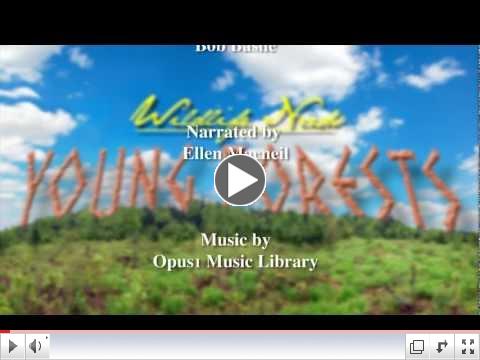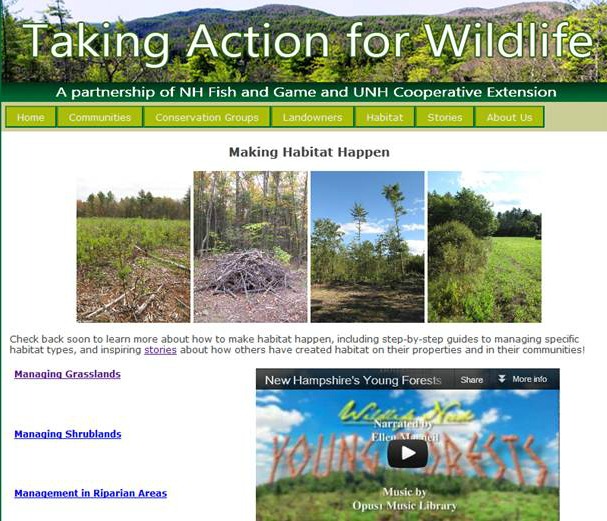|
|

A partnership of NH Fish and Game and UNH Cooperative Extension |
|
New Hampshire's Wildlife Action Plan News and Updates
|
Fall 2012
|
|
|
|
|
Visit takingactionforwildlife.org
| |
|
|
|
|
|
|
|
Young Forests Provide Valuable Wildlife Habitat - View the Video!
New
England cottontails, eastern towhees, American woodcock, chestnut-sided
warbler; these are among the seventy wildlife species in New Hampshire
that depend on young forest habitats for their survival. Many of
these species have seen their numbers declining for many decades because
of a lack of young forest habitat, which includes aspen-birch forest,
shrubby old fields, shrub swamps, pine barrens, and even regenerating
clearcuts. Find out what landowners, foresters, and biologists are doing
in New Hampshire to try to reverse these declines by using tried and
true habitat management techniques including tree harvesting, prescribed
burning, and mowing. Watch NH Fish and Game's new 6-minute video clip on young forest habitats (see below). Find out more about young forest habitats on Taking Action for Wildlife's Young Forest Habitat page
 | | New Hampshire's Young Forests |
|
|
What's New on the Web? 
Take a look at some new information on the Taking Action for Wildlife web pages (takingactionforwildlife.org)
Making Habitat Happen Learn about different habitats and how you can help to make habitat happen. Read inspiring stories about how others have created habitat to benefit wildlife.
Bath Natural Resources Inventory (September 2012)
Hot off the press, take a look at a natural resources inventory written by a conservation
commission.
The Bath NRI used wildlife as common thread throughout the NRI, using
information from the Wildlife Action Plan and Taking Action for
Wildlife.
Managing & Restoring Habitats - Stories and examples - we have expanded the list of stories from public and private landowners. Find out what some landowners and communities have done to enhance wildlife habitat on their properties.
|
|
Discover and Explore New Hampshire's Natural Wonders:
 A Field Guide to The Nature Conservancy's Preserves and Conservation Project Areas A Field Guide to The Nature Conservancy's Preserves and Conservation Project Areas
The fall is a wonderful time to get outdoors and enjoy the natural beauty of the
New Hampshire landscape. Here is a great opportunity to explore and
learn about some unique local habitats. Take a look at The Nature
Conservancy's (TNC) new field guide Discover and Explore New Hampshire's Natural Wonders (2012). "In this field guide, you'll find those wonderfully rich details on the habitats, wildlife and human history of our preserves."
Through this well-written and beautifully illustrated guide, you are
invited to discover TNC's 43 nature preserves and conservation areas in
New Hampshire - and of course it is a great opportunity to explore some
great wildlife habitats! The guide is neatly divided into six
color-coded chapters representing broad geographic regions, including:
Great North Woods, White Mountains, Lakes Region, Upper Valley and
Monadnock Highlands, Lower Merrimack Valley and the Seacoast. Read More
|
|
Land Trusts Using the Wildlife Action Plan a nd the WAP Maps nd the WAP Maps
The NH Wildlife Action Plan (WAP) was published in the spring of 2006, and along with this huge document the NH Fish and Game Dept. developed and released
maps of wildlife habitat and habitat condition. The WAP itself is full
of analyses of species and habitats and includes individual species and
habitat profiles making up 75% of the 1,183 page document. So how has
this plan helped these species and habitats? One measure of success is the amount of habitat protected since the plan and maps were published. Read More
|
|
New Hampshire's Black Racers - A Species to Watch

Do you find yourself reminiscing about frequent encounters with black racer snakes as a child? You are less likely to have
these encounters now with black racers becoming less common. The black
racer has actually declined to the level of state-threatened. As a
species reliant on early-successional habitats, the heavily forested landscape of today has taken over many of their preferred habitats, reducing their populations and distribution statewide. To develop conservation strategies for sustaining
the species in New Hampshire, biologists at NH Fish and Game have been
researching habitat use and movement patterns of black racers. Read More
|
|
Making Habitat Happen:
From Bunnies to Birds, Managing State Lands for Wildlife

Out for a walk at
Bellamy River Wildlife Management Area (WMA) in Dover, NH, I was alerted
to the sounds of large machines advancing through fields, planting
shrub seeds. I noticed log skidders piling newly cut trees at a landing
and industrial-strength mowers chopping down old, past-their-prime
shrubs so they'll grow back as thick cover. What's happening here?
Conservationists are using all of these techniques and more to turn
Bellamy River WMA into a habitat showcase while boosting the local New England cottontail population. Read More
|
|
Newsletter Editor: Amanda Stone (UNH Cooperative Extension)
Photo Credits:
Frank Mitchell (Banner photo, salamander), Malin Clyde (Coverts), Emma
Carcagno (Making Habitat Happen), Emily Brunkhurst (Land Trusts Using
WAP), Black Racer (Brendan Clifford), Amanda Stone (Fall wetland)
|
|
|
|
|
|
|
|
|